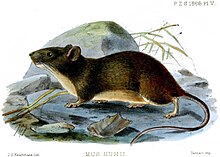Hadromys humei
| Manipur bush rat | |
|---|---|
 |
|
| Scientific classification | |
| Kingdom: | Animalia |
| Phylum: | Chordata |
| Class: | Mammalia |
| Order: | Rodentia |
| Family: | Muridae |
| Genus: | Hadromys |
| Species: | H. humei |
| Binomial name | |
|
Hadromys humei (Thomas, 1886) |
|
| Synonyms | |
|
Mus humii |
|
Mus humii
The Manipur bush rat (Hadromys humei) also known as Hume's rat or Hume's hadromys, is a species of rodent in the family Muridae. It is found in northeastern India, and is listed as endangered.
The species is endemic to northeast India, and has been recorded from several localities. These are: Angarakhata in Kamrup district (Assam), Bishnupur, Imphal, Senapati and Karong (specimen FMNH 76562) in Manipur.
Originally thought to occur in Yunnan in China also, the Chinese animals have been reclassified as Hadromys yunnanensis Yang & Wang 1987. The fossil record shows that populations of the Manipur Bush Rat existed all over Thailand right down to the Thai-Malay border during the . During that time, the Indo-Malayan region may have had a cooler and drier climate with savanna-like regions. A related species is known from the Siwalik fossils from northern Pakistan. These findings indicate that Hadromys humei is probably a "relict" species.
The Manipur bush rat occurs at medium altitudes from 900 to 1,300 metres (3,000 to 4,300 ft) above sea level. It inhabits tropical evergreen, moist deciduous and evergreen forests and also found in secondary forests in northeastern India.
The murid was described by Oldfield Thomas in 1886 from specimens in the Manipur collection of Allan Octavian Hume, which was donated to the British Museum (Natural History) after Hume's life's work in ornithological notes were sold by a servant as waste paper. The Manipur Bush Rat was named in his honour. The collection has two male and two female specimens, recorded to be collected on 23 March 1881 from "Moirang" (in Manipur), the type locality for this species.
...
Wikipedia

